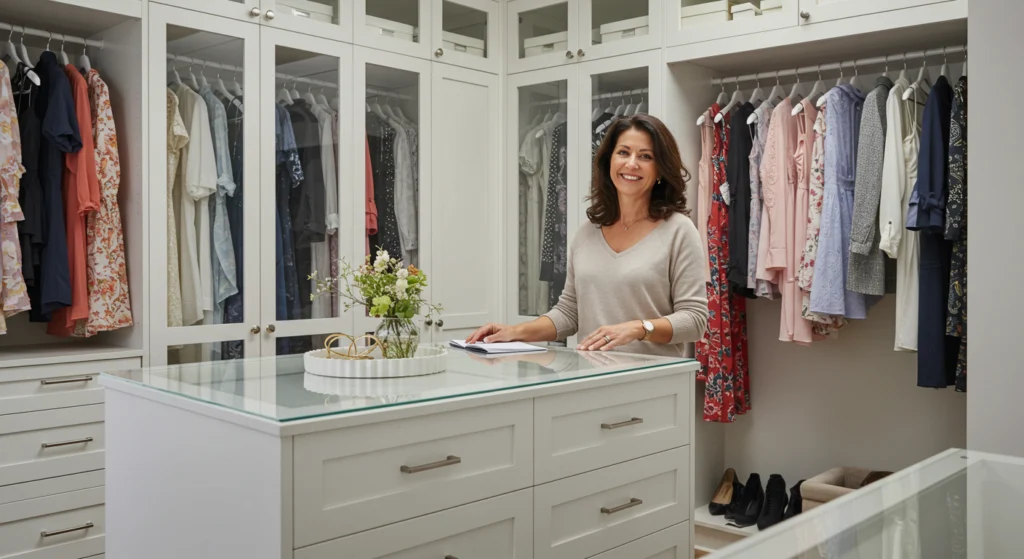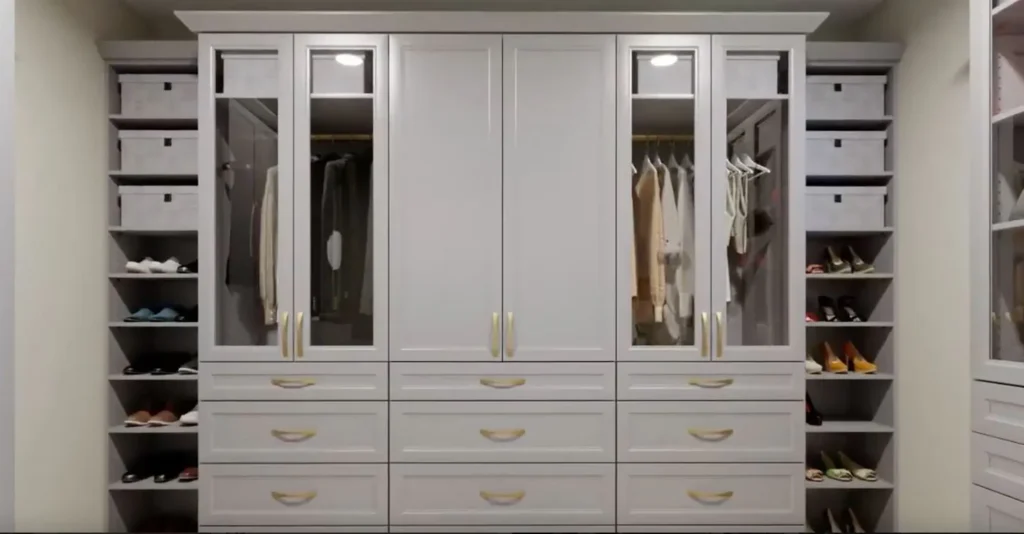
Custom walk-in closets are more than a place to hang clothes, they’re a selling point that can bump a home’s appraised value. Recent market data shows that these upscale storage spaces typically return 50% to 60% of their installation cost at resale. For homeowners weighing the cost of an upgrade against the eventual payoff, that number makes custom walk-ins one of the more reliable investments in the home improvement world.
This first section of a three-part guide explains how that resale premium is calculated and why buyers are willing to pay extra for homes with beautifully designed walk-in closets.
Why Walk-In Closets Command Higher Offers
A well-designed walk-in closet changes how a home feels. It adds an element of luxury and order that buyers notice the second they step inside. Appraisers see it too, noting that homes with premium closet systems often sell faster and closer to asking price.
High-quality materials, integrated lighting, and smart storage systems tell buyers a property is well cared for and move-in ready. That perception of quality translates directly into stronger offers and a measurable boost in appraised value.
Typical ROI: 50% to 60%
Industry studies and real estate appraisers generally agree that homeowners recoup about half to a little more than half of their installation cost when they sell.
- A $4,000 installation can raise resale value by roughly $2,000 to $2,400.
- Larger, higher-end projects costing $8,000 might yield a $4,000 to $4,800 bump.
This doesn’t even count the potential for a faster sale, which can save on mortgage payments and carrying costs.
If you need ideas on design and materials that help hit that ROI sweet spot, review the inspiration in Closets Plus custom closets to see how local Florida projects balance cost and value.
Market Conditions Matter
Location affects how much of your investment you’ll recoup.
- Competitive coastal markets: In places like Sarasota or Naples, luxury buyers often view walk-in closets as essential. Appraisers may lean toward the higher end of the ROI range here.
- Suburban settings: ROI often holds steady if the closet includes thoughtful features like adjustable shelving and valet rods.
- Low-demand areas: The percentage can dip slightly, but even modest markets show that quality storage sells homes quicker.
Checking recent home sales data on reliable sites such as the National Association of Realtors can provide a local snapshot of how buyers value closet upgrades in your area.
Key Design Choices that Influence ROI
Not every walk-in closet earns the same return. Appraisers weigh several factors:
- Size and layout – A well-planned footprint with room to move is worth more than a cramped retrofit.
- Material quality – Solid woods or premium laminates outshine low-end particleboard.
- Lighting and organization – LED strip lights, shoe walls, and custom drawers show buyers that the space is both attractive and practical.
The featured articles at Closets Plus highlight designs that meet these standards, from elegant finishes to energy-efficient lighting.
Buyer Appeal Extends Beyond Luxury Homes
While grand walk-in closets are common in high-end houses, even mid-priced properties benefit from a custom storage upgrade. Buyers across income levels consistently rank organized storage as a must-have. According to real estate agents, homes that feel uncluttered and efficient create an immediate positive impression, which helps explain the steady 50%–60% ROI figure seen across markets.
Examples of Cost vs. Resale Premium
- Modest Upgrade: $3,500 custom installation → resale premium about $1,800 to $2,100.
- High-End Build: $10,000 walk-in with island and custom lighting → resale premium around $5,000 to $6,000.
These numbers align with appraiser surveys and national cost-versus-value reports, showing that homeowners can confidently expect a significant portion of their investment back when they sell.
Why Walk-Ins Help Homes Sell Faster
Beyond the dollar figure, walk-in closets give sellers an edge in competitive markets. A well-lit, organized closet photographs beautifully for listings and shines during showings. Buyers picture their own wardrobes neatly arranged, which can shorten the time on market and reduce the need for price cuts.
For a closer look at designs that help properties move quickly, see the kitchen and storage gallery from Closets Plus, many of the same principles apply to bedroom closets.
Breaking Down the Real ROI
Understanding the numbers behind a custom walk-in closet’s resale premium helps homeowners decide where to invest. While the headline ROI range of 50% to 60% is a reliable average, the details of your project, materials, size, and design, ultimately shape the actual return.
Cost vs. Value: A Closer Look
Industry cost-versus-value reports show that a mid-range custom closet typically costs $3,000 to $6,000. Homes listed with these upgrades often appraise for an additional $1,500 to $3,600 in value.
A higher-end walk-in closet with luxury finishes, lighting, and an island may run $8,000 to $12,000, with an estimated resale premium of $4,000 to $7,000. The percentage stays consistent, but the absolute dollars increase with higher-quality projects.
To double-check your local market numbers, consult reliable data sources such as the National Association of Realtors Cost vs. Value report, which tracks remodeling ROI nationwide and by region.
Why the Market Influences Returns
The same closet upgrade can bring different returns in different markets:
- High-demand metro areas – In places with strong buyer competition, appraisers may lean closer to the 60% ROI mark.
- Coastal Florida – Salt air and humidity make durable, moisture-resistant materials a bigger selling point, nudging ROI higher.
- Smaller towns – In less competitive markets, ROI might land nearer the 50% range, though the upgrade still improves marketability.
Researching recent comparable sales on trusted platforms like your county’s property appraiser site or HUD’s housing data can give a clearer picture of regional buyer expectations.
Features that Add the Most Value
Not all design choices produce equal returns. Appraisers and seasoned real estate agents consistently point to specific features that signal quality and usability:
- Integrated lighting – LED strips, recessed fixtures, and motion sensors enhance both aesthetics and function.
- Smart organization – Valet rods, shoe walls, and accessory drawers keep clutter hidden and space maximized.
- Premium finishes – Solid wood cabinetry or high-end laminates outperform basic wire racks and particleboard.
For practical inspiration, browse the design galleries on Closets Plus to see how these elements work together in real homes.
Speed of Sale: An Overlooked Advantage
Faster sales can be as valuable as direct ROI. A home that sells in two weeks instead of two months saves owners money on mortgage interest, utilities, and property taxes. Appraisers don’t always quantify that benefit, but agents repeatedly cite walk-in closets as a feature that helps listings move quickly.
Sizing Up Your Project
Whether you’re converting a spare bedroom or expanding an existing closet, size matters for both cost and value:
- Small walk-in (25–40 sq ft) – Typically adds a modest premium but still appeals to buyers seeking organized storage.
- Medium walk-in (50–80 sq ft) – Ideal balance of cost and impact for most homes.
- Large luxury walk-in (100+ sq ft) – Commands attention in upscale properties and can justify a higher price point.
The featured articles from Closets Plus outline examples of each type, with insights on balancing space and budget.
Avoiding Over-Customization
While personalization is tempting, hyper-specific designs can narrow buyer appeal. Appraisers caution against bold color schemes or quirky layouts that might clash with a buyer’s vision. Neutral finishes and adaptable storage configurations, like adjustable shelves and removable dividers, keep ROI strong across diverse tastes.
Materials and Durability
Florida homeowners in particular should focus on moisture-resistant woods or high-quality laminates that can stand up to humidity. Rust-resistant hardware and soft-close hinges signal a premium build, something appraisers and buyers alike notice immediately.
Planning and Budgeting for a High-ROI Walk-In Closet
To capture the 50–60 % resale premium that custom walk-in closets typically generate, careful planning is critical. The last stretch of this guide focuses on budgeting, working with professionals, and presenting your finished upgrade so appraisers and buyers fully recognize its value.
Create a Realistic Budget
Start by setting a firm budget range, most quality projects fall between $4,000 and $10,000. Break costs into three major buckets:
- Core materials – cabinetry, shelving, hardware
- Lighting and electrical – recessed LEDs or motion sensors
- Labor and finishing – professional installation, trim, paint
Prioritize structural and organizational elements first. Decorative extras, like specialty drawer pulls or designer wallpaper, can always be added later without affecting core ROI.
Work with a Professional Designer
A professional design consultation ensures every inch of space is functional and attractive. Designers will:
- Take precise measurements and create a 3D layout
- Recommend durable, moisture-resistant materials
- Suggest smart storage solutions such as double-hanging rods and pull-out hampers
Experienced installers also handle the fine details, level shelving, smooth door operation, and hidden fasteners, that appraisers notice right away. You can browse completed projects on the Closets Plus custom closets page to see how professional design translates to real-world results.
Documentation for Appraisal
When the work is complete, collect and save all invoices, design plans, and warranties. Provide these to the appraiser so they can accurately factor the investment into the property valuation. High-resolution photos of the finished space also help showcase the upgrade.
Showcase Value During Sale
Before showings, keep the closet spotless and staged. Bright lighting, neatly arranged clothing, and a mild scent all create a boutique feel that sticks with potential buyers. Many sellers even schedule the appraisal immediately after installation to capture the closet’s fresh look and functionality.
Features That Impress Every Buyer
To appeal to the widest audience and keep that ROI strong, consider these universally admired details:
- LED lighting with motion sensors for energy efficiency
- Adjustable shelving to adapt as needs change
- Neutral color palettes that complement any style
- Quality hardware such as brushed nickel or matte black finishes
For additional ideas, review the featured articles section of Closets Plus, where current trends meet proven resale strategies.
Whole-Home Consistency
A walk-in closet looks even better when finishes coordinate with the rest of the home. Matching cabinet styles or hardware with the kitchen or bath, see the Closets Plus kitchen gallery for inspiration, creates a seamless aesthetic that appraisers often reward.

Final Takeaways
- Typical ROI: Expect to recover 50–60 % of installation costs at resale.
- Market Advantage: Homes with custom walk-in closets frequently sell faster and closer to asking price.
- Key Upgrades: Integrated lighting, durable materials, and adaptable organization deliver the highest returns.
By budgeting wisely, working with seasoned professionals, and presenting the finished closet effectively, homeowners can turn a simple storage upgrade into a compelling selling feature that adds measurable value.
Quick Resources for Further Guidance
- National Association of Realtors – Up-to-date remodeling ROI data
- HUD Housing Data – Regional market trends and housing insights
- Closets Plus – Local design expertise and real-world project examples
Bottom line: A custom walk-in closet is more than a luxury, it’s a strategic investment. With thoughtful planning and professional execution, sellers can confidently expect a strong resale premium while enjoying an organized, elegant space every day until closing.


